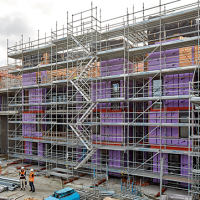Articles | Sustainability
Global Warming Puts The Heat On NZ’s Building Industry
Tuesday, 1 December 2020
By Graeme Robertson
We in the building industry, from builders and designers to manufacturers and suppliers can no longer keep our heads down and ignore climate change or global warming.
Our government has committed NZ to pulling its own weight and is requiring, not asking, most business sectors to be Carbon zero by 2050 to align with the ‘Paris Global Accord’. Agreed to by 195 nations, the accord aims to limit the earth’s temperature rise to 1.5 deg. C.
NZ’s ‘National Climate Change Commission’ which was established under the ‘Climate Change Amendment Act 2019’ has issued its first report. It’s not pretty. We could be in for a rough ride as sea levels rise and we are impacted by heat, drought, fires, increasingly violent storms and challenged food production. Our team of 5 million is being summoned again.
MBIE has been tasked to plan and drive implementation in the building and construction industries. The built environment is estimated to be responsible for up to 20% of NZ’s greenhouse gas emissions. There is a 2-pronged plan of attack to make significant changes to the way these sectors operate. The goals are firstly to reduce greenhouse gas emissions and secondly to get NZ buildings ready for the predicted impacts of global warming.
Starting with new builds, MBIE is setting high standards for energy and water use as well as air quality and required temperature ranges for wellbeing. The embodied carbon and emissions from construction materials, the actual construction process and the waste must be measured and fall within set limits.
In order to get building consent, projects will need to show up front, how the new standards will be achieved. There are proposed guidelines for how to make and submit calculations, with the required targets ramping up, with a wider net, over a set time frame. According to a recent study we need to reduce the carbon footprint of an average new house by a factor of about 5. The finish line is 2050.
Reducing waste plays a big role and so quantities will need to be reported and certified in waste management plans. It has been measured that for a typical house an average of 17% of plasterboard is wasted. This is not only a lot of carbon but also a lot of money. Long term saving the planet, short term money in the pocket!
Re-cyclable products made locally and sustainably such as GIB® Plasterboards, have a much lower carbon footprint which will help to achieve these upcoming new requirements. Winstone Wallboards as a manufacturer is committed to reducing its own Carbon emissions 30% by 2030 and be carbon zero by 2050. We have pledged to work with our supply chain partners and customers to assist them and the construction industry build sustainably and contribute our fair share towards a sustainable future. Additionally, through careful planning and utilising the wide range of GIB® plasterboard lengths and widths wastage can be greatly reduced.
Visit our sustainability page for more information.
Read next
Articles | Exterior Systems
New GIB Weatherline® Design and Construction Manual December 2020 Release
Tuesday, 1 December 2020 By Gordon White
